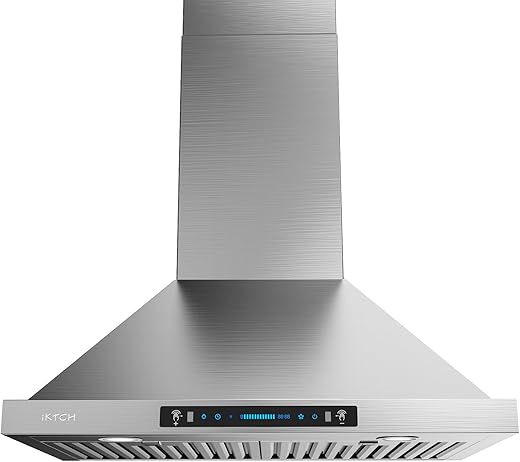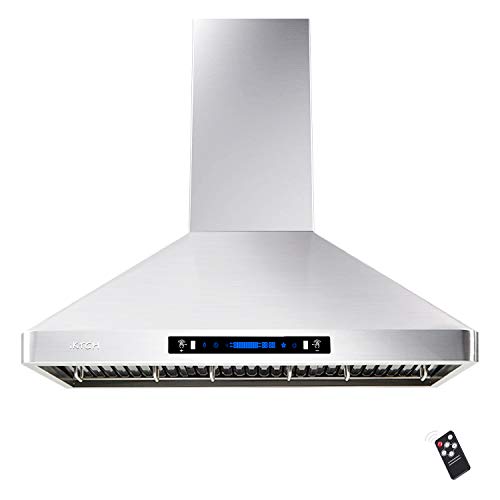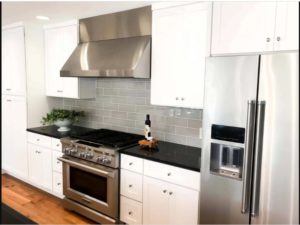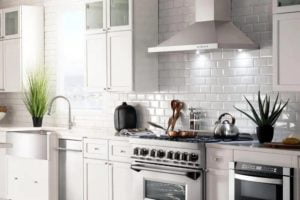Disclaimer: There are affiliate links in this post. At no cost to you, I get commissions for purchases made through links in this post.
I want to upgrade my kitchen range hood, but the options available on the market are overwhelming. What is the difference between ducted and ductless range hoods, and what is a convertible model
Range hoods are essential for every indoor kitchen, removing smoke, fumes, and cooking oil from the air after cooking is complete. By filtering and recirculating the air or redirecting it out of the home, these devices are typically placed on top of a stove and improve air quality in one of two ways.
There are both ducted and ductless range hoods available for purchase and convertible range hoods that offer both ducted and ductless functionality. Continue reading to understand better what a convertible range hood is and the factors to consider when searching for the best option.
What Is a Convertible Range Hood?
The first question that comes to mind is, “What does a range hood do?” With or without ductwork for ventilation, a convertible range hood is an appliance designed to remove smoke, steam, grease, cooking fumes, and odors from the air in your kitchen. Using a range hood to collect grease and smoke from the air results in less oily residue on your walls and ceiling, making your kitchen – and the air you breathe – cleaner, even if your range hood fan cannot be vented to the outside.
There are various range hood designs available. These are among the most popular:
- A range hood mounted to the wall is installed directly above the stove.
- An under-cabinet range hood can be installed beneath an over-the-stove cabinet.
- A ceiling-mounted or island range hood is affixed to the ceiling, allowing it to be installed above an island stove away from a wall.
- There are three types of range hoods: vented, non-vented, and convertible. Convertible range hoods can be utilized for either or both configurations, making them versatile, adaptable, and highly functional.
How Does a Vent Hood Work?
A range hood with ventilation utilizes a fan to remove the kitchen’s steam, smoke, heat, grease, and cooking odors. It then releases them outside through a duct or vent. If you require a range hood with a high CFM at the professional level, you will need a ducted or ventilated system. Typically, the filter is made of stainless steel or aluminum mesh. The mesh filter collects grease and smoke particles, preventing them from escaping through the vent. These are very simple to clean.
Container slightly larger than the filter; a large baking pan with sides may suffice, or it may fit in your sink.
Non-ventilated
A range hood that is not ventilated has a fan but no duct to the outdoors. Instead, it filters the air and recycles it back into the kitchen using filters. The filter is the essential component of a non-ventilated system, and there are a variety of types
Convertible
Convertible range hoods can utilize either ducted or ductless ventilation systems. It features a powerful fan that can be attached to a duct and vented to the outside, as well as a metal mesh and charcoal filter through which the air is circulated to remove odors and particles for recirculation. Depending on the configuration of your kitchen, you can install convertible range hoods that either recirculate or vent through ductwork.
There are advantages and disadvantages to each ventilation system. Choosing a convertible range hood allows for greater placement flexibility.
Factors To Consider When Choosing Convertible Range Hood
Through an air duct or filtered recirculation, range hoods remove fumes and odors from the kitchen.
Choosing a ducted or ductless oven range hood is one of the most critical decisions consumers must make when purchasing one.
Ducted range hoods draw in air and exhaust it outside. They may also be referred to as range hoods with ventilation. Ducted models are typically quieter because their fans can be in the ductwork instead of the hood. Although they are the most effective option available, they are more challenging to install because they require a system of ductwork that leads outside, which may not be compatible with every kitchen design.
Ductless range hoods, also known as recirculating range hoods, are equipped with a suction fan that draws air from the kitchen, filters it, and then recirculates it back into the space. Typically made from charcoal, these filters effectively capture grease and odor particles. Ductless range hoods are better than nothing, but they cannot compete with ducted models in terms of performance. Commonly found in rental units and kitchens where installation of a ducted model is not feasible.
A convertible range hood is adaptable to both ducted and ductless installation.
Convertible range hoods are flexible appliances that can operate with or without a duct system. They include fans and the necessary connections to connect them to a ventilation system and charcoal filters for ductless operation. They are generally sold as ducted hoods and can be converted to ductless operation using a separately sold conversion kit.
Consider the mounting style, hood size, and fan power, typically measured in cubic feet per minute, when shopping for a range hood (CFM). Typically, residential range hoods of superior quality have CFM ratings between 300 and 500.
A recommended convertible range hood is the ZLINE 36′′ Convertible Vent Wall Mount Range Hood, which is constructed of stainless steel, has high-quality baffle filters, and moves 400 cubic feet of air per minute.
Convertible range hoods may incur additional expenses.
Cost can be a factor when deciding which type of range hood is best for a kitchen. Convertible range hoods may be more expensive than standard ducted or ductless models despite their convenience.
Some range hoods are marketed as convertible and initially appear to be a good value, but the cost of the conversion kits must be accounted for as they are frequently sold separately. Users must purchase and regularly replace charcoal filters when using the range hood as an air circulator. Before deciding on a range hood that seems to fit a budget, it is essential to consider the prices of these extra components.
Convertible range hoods provide greater versatility for future kitchen renovations.
If you plan to renovate your kitchen in the future but need to replace your range hood immediately, a convertible model is an excellent choice. They are a perfect option if you do not currently have ductwork leading from your kitchen but plan to install it in the future.
A convertible model enables you to use the kitchen range hood as a recirculating filter system before converting it to a more effective vented system. If you relocate your stove to an interior wall where installing a ventilation system isn’t possible, the range hood vent will still work effectively.
Typically, convertible range hoods offer more design options than ductless models.
Wall-mounted and under-cabinet options are the most common types of range hoods. Wall-mounted range hoods are typically ducted and mounted directly on the wall. Under-cabinet models are ideal for those with limited space, as they attach to the underside of your kitchen’s upper cabinets. Many under-cabinet models are ductless, making installation without a professional simple.
Ductless range hoods are relatively unremarkable, whereas ducted range hoods tend to be visually arresting focal points in a kitchen. If a style is a priority, consumers can purchase a ducted option with a convertible kit to achieve the upscale appearance of a kitchen exhaust hood, even if it is not connected to any kitchen vent.
Best Convertible Range Hood 2022
Everything to know about Convertible Range Hood - FAQs
A convertible model enables you to use the kitchen range hood as a recirculating filter system before converting it to a more powerful vented system. The range hood vent will also function properly if you relocate your stove to an interior wall where installation of a ventilation system is not feasible.
A ducted range hood must be connected to a duct with pipes transporting airborne particles outside the kitchen. This distinguishes it from ductless range hoods, which merely recirculate air through a filter before returning it to the kitchen.
It can vent through a wall or ceiling using a duct, or it can be converted to non-venting (filters the air and blows it back into the kitchen) using Recirculation Kit Part Number W10294733, which is available from your dealer or an authorized parts distributor.
A convertible range hood can be converted from ducted to ductless operation. Typically, they are ducted hoods that can be converted to ductless with a recirculating kit. A recirculating kit is attached to the range hood’s top.
Yes. Like a ducted range hood, a recirculating range hood performs admirably. The primary difference is that the air is filtered and then recirculated back into the home instead of being exhausted from the outdoors.
Conclusion
Choose a range hood that complements your space, architecture, and aesthetic. After these factors have been considered, examine the features and performance. Our mission is to provide an entirely new cooking experience by reimagining the range hood for your kitchen. Contact us immediately if you wish to learn more about convertible range hoods.
Related Posts
Best under cabinet range hood for your home
Disclaimer: There are affiliate links in this post. At no...
Read MoreWhy Trust Us
You will find what you are looking for at Largo Bar and Grill. From classic to luxury brands, you'll find both. We will help you to select appliances that fit your needs, budget and lifestyle. Whether you want to stop by to learn more — or plan to make a major purchase — we’ll treat you like family and assist you every step of the way. Shop with us today to receive friendly and experienced help along the way.













